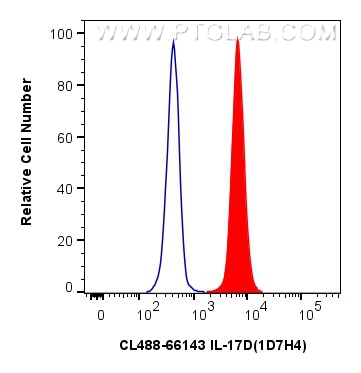IL-17D Monoklonaler Antikörper
IL-17D Monoklonal Antikörper für FC (Intra)
Wirt / Isotyp
Maus / IgG2b
Getestete Reaktivität
human
Anwendung
FC (Intra)
Konjugation
CoraLite® Plus 488 Fluorescent Dye
CloneNo.
1D7H4
Kat-Nr. : CL488-66143
Synonyme
Geprüfte Anwendungen
| Erfolgreiche Detektion in FC (Intra) | humane PBMCs |
Empfohlene Verdünnung
| Anwendung | Verdünnung |
|---|---|
| Durchflusszytometrie (FC) (INTRA) | FC (INTRA) : 0.25 ug per 10^6 cells in a 100 µl suspension |
| It is recommended that this reagent should be titrated in each testing system to obtain optimal results. | |
| Sample-dependent, check data in validation data gallery | |
Produktinformation
CL488-66143 bindet in FC (Intra) IL-17D und zeigt Reaktivität mit human
| Getestete Reaktivität | human |
| Wirt / Isotyp | Maus / IgG2b |
| Klonalität | Monoklonal |
| Typ | Antikörper |
| Immunogen | IL-17D fusion protein Ag6762 |
| Vollständiger Name | interleukin 17D |
| Berechnetes Molekulargewicht | 22 kDa |
| Beobachtetes Molekulargewicht | 28 kDa |
| GenBank-Zugangsnummer | BC036243 |
| Gene symbol | IL-17D |
| Gene ID (NCBI) | 53342 |
| Konjugation | CoraLite® Plus 488 Fluorescent Dye |
| Excitation/Emission maxima wavelengths | 493 nm / 522 nm |
| Form | Liquid |
| Reinigungsmethode | Protein-A-Reinigung |
| Lagerungspuffer | PBS with 50% glycerol, 0.05% Proclin300, 0.5% BSA |
| Lagerungsbedingungen | Bei -20°C lagern. Vor Licht schützen. Nach dem Versand ein Jahr stabil. Aliquotieren ist bei -20oC Lagerung nicht notwendig. 20ul Größen enthalten 0,1% BSA. |
Hintergrundinformationen
IL17D is a secreted cytokine with homology to the IL-17 family of proteins. IL17D is preferentially expressed in skeletal muscle, brain, adipose tissue, heart, lung, and pancreas. The treatment of endothelial cells with IL17D has been shown to stimulate the production of other cytokines including IL6, IL8 and CSF2/ GM-CSF. The increased expression of IL8 induced by IL17D was found to be NF-kappa B-dependent.
Protokolle
| PRODUKTSPEZIFISCHE PROTOKOLLE | |
|---|---|
| FC protocol for CL Plus 488 IL-17D antibody CL488-66143 | Download protocol |
| STANDARD-PROTOKOLLE | |
|---|---|
| Klicken Sie hier, um unsere Standardprotokolle anzuzeigen |


